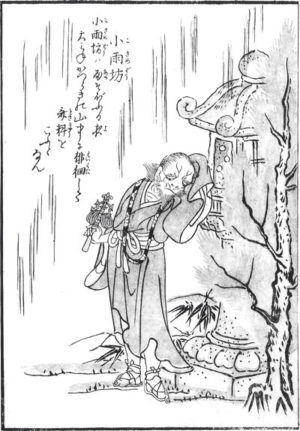The Kickstarter topped 700% last night, which is amazing, considering we’re not even one week in! My previous two Kickstarters both managed to reach 900% on their final days, and it looks like The Book of the Hakutaku will reach that much earlier. It really is great to see that there are so many more yokai fans today than there were just a couple of years ago!
If you’re enjoying A-Yokai-A-Day, remember to become a backer for The Book of the Hakutaku on Kickstarter! Now, for today’s yokai:
Raijū
雷獣
らいじゅう
Raijū is an interesting yokai. Once upon a time it was one of the most well known and most feared supernatural creatuires in Japan. Yet today it is relatively minor, or even practically unknown to the average person. Why the sudden change? Science of course!

Japan’s history is filled with natural disasters. Earthquakes, tsunamis, typhoons, floods, and fires have done more than their fair share of destruction to the country. While we know much about the physical causes of natural disasters today, in earlier eras they were mysterious, considered to be the work of gods. Only gods had the power to move the earth, or send fire from the sky. Lightning, for example, occurs so fast and so randomly that it is all but impossible to observe. Only its aftereffects can be observed—the terrible sound that shakes the world, the weirdly shaped burns on the thing it strikes, and the fires that it starts. Particularly in old Japan when homes were all made of wood and closely packed together, a single lightning strike can cause a lot of damage!

The raijū was the personification (animal-ification?) and embodiment of lightning. They were seen as a kind of god, or at least akin to the thunder gods (raijin). They live in the sky, which was a world which was totally off limits to pre-flight humans. They rode bolts of lightning to earth. For seemingly no reason at all, they would strike buildings, start fires, and cause mass destruction. Nothing was known about them, and nothing could be known about them except that they were fast, merciless, and deadly. Whenever lightning struck, people believed that a raijū had been sent by the gods to punish them for some reason or another.

Raijū took on lots of forms over their history. Generally, they were thought to look like wolves, dogs, tanuki, or even weasels or cats. They had long, sharp claws and ferocious faces. Far more fanciful forms existed too. Sometimes raijū were said to look like little dogs, but with four rear legs and two tails. Sometimes they were said to look like insects or crustaceans. They would burrow into your belly button to hide from the angry thunder gods (which is where the Japanese superstition of covering your belly button when thunder claps comes from!). Others looked like miniature dragons. Even more exotic versions were chimerical monsters composed of many different animals, like the nue (who is really a kind of raijū when you think about it).

Because they were so scary, raiju were often presented in stories as beasts to be slain, just like oni. The nue, as mentioned above, is one such example. Another example involves the historical samurai Tachibana Dōsetsu. One night he was taking shelter from a storm under a tree. Lightning struck him, but he drew his sword just in time to strike the bolt, slaying the raijū who came with it. Afterwards, he named his sword Raikiri, or “lightning cutter.”

During the Edo period, “real” raijū were popular sideshow attractions, along with “real” kappa and mermaids. Mummified remains of cats, monkeys, and dogs presented as raijū were often toured around the country in traveling shows. People would pay a few coins to get a quick glimpse at the horrific corpses. Surely many must have realized that these were just man-made taxidermied monstrosities, but their popularity boomed anyway due to the sheer horror that they evoked.

During the Meiji period, with the rapid changes tranforming society thanks to the influx of foreign science and technology, yokai were one of the first victims. People were actively discouraged from bringing up “silly” superstitions because they were perceived as an embarrassment to the country—they were examples of how parochial and backwards the Japanese were in the previous era. New understandings about electricity and lightning, and the invention of the airplane made the raijū’s most important features—its life in the mysterious sky, and its attachment to lightning—suddenly no longer mysterious. Once those mysteries were gone, the raijū had nowhere left to live.
I’ve talked a lot before about how yokai are necessarily creatures of mystery. They live in the borderlands between life and death, light and shadow; they’re aren’t creatures of death, and they aren’t creatures of the night. They’re something intangible and unknowable. We can’t classify them the way we classify animals, because their very nature is that they are unclassifiable. Once we know too much about them, they cease to be interesting.
The raijū was a victim of probably the one thing that can truly kill a yokai: understanding.

Raiju, from The Book of the Hakutaku






















